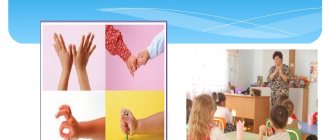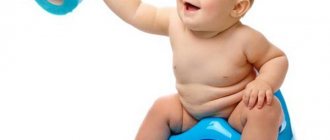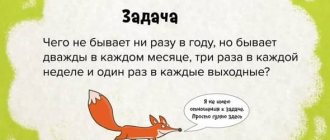Finger gymnastics “Wild Animals” in the senior group
We offer poems with instructions for performing finger gymnastics in the senior preschool group. The teacher reads the poem, shows what movements to perform, and the students repeat after him.
In the forest
Fingers, where have you been? - children make the “class” sign, stick out their thumb;
Fingers walked through the forest. — raise and lower the hands asynchronously;
There's a bunny, a bear, a wolf,
And there's a hedgehog covered in spines. - take turns touching the right thumb with the tips of the index, middle, ring and little fingers;
We saw a snake, a fox,
Also badger, marten. - take turns touching the left thumb with the tips of the index, middle, ring and little fingers;
We walked through the forest for a long time,
All the paths have been trampled. - raise the hands, rotate them left and right.
Hibernation
Children have five fingers - pupils take turns unclenching their right and left fingers, starting with the thumb;
We went for a walk in the forest in winter. - raise the hands, rotate them left and right;
The wolf and the fox don’t want to sleep; they clench and unclench their right and left fists;
And the bear is dreaming. — place their combined palms under their cheeks, as if they are sleeping;
The hedgehog in the hole is curled into a ball; they take turns combining the tips of the right and left fingers;
And the badger went to bed. - take the combined fingers away from each other;
Good dreams to the little animals,” they clasp their hands in the shape of a “castle”;
All the guys wish! - clap their hands.
Forest Dwellers
Now we learn from the footprints - the children fold their hands in a vertical “boat”;
Who lives in the forest? - open the “boat”;
Here are the tracks of a fox,” bend the right thumb;
Wolf, small bird - right index and middle;
Boar, little hare - right ring and little fingers;
Bear and hedgehog - bend the left thumb and index fingers;
Nimble squirrel, lynx, left middle and nameless;
And elk were found. - left little finger;
Oh, how many inhabitants there are in the forest! - Raise your arms above your head, then smoothly spread them to the sides.
In the forest
There are fir trees in the thicket of the forest; children join their palms in a triangle;
Angry wolves prowl beneath them. - show a “wolf face” - bend the index finger, put the thumb aside, move the little finger up and down;
Little bunnies rarely run - they straighten their index and middle fingers, move them, imitating bunny ears;
The branches of the spruce trees are touching. - move relaxed hands in different directions;
Teddy bear cub,
Tears off branches with a large paw. - clasp the fingers, depicting a bear’s head, and put the combined thumbs aside, imitating a bear’s nose;
There's a little hole under the tree,
This is a house for a hedgehog. - fold the brushes into a ball shape.
The importance of finger exercises for the development of preschool children
Finger games and finger gymnastics are a type of children's motor activity, the main goals of which are:
- development of fine motor skills of the hand, palm and fingers;
- improvement and enrichment of tactile sensations;
- development of skills to manipulate small objects and perform actions with them.
Unlike games, finger gymnastics has a clearer, fixed structure, involves performing actions in a certain order, according to the model shown by the teacher, and includes elements of self-massage. But since finger games are exciting, dynamic and have a great influence on the development of the emotional sphere of preschoolers, they can also be used during organized educational activities as a type of light gymnastics for the palms and fingers.
Why are exercises for fingers and palms so useful in preschool age? The well-known phrase of V. A. Sukhomlinsky “The child’s mind is at the tips of his fingers” reveals one of the main goals of these exercises: to promote the development of intelligence, cognitive activity, and curiosity of the baby.
Unlike adults, for children to get a complete understanding of a subject, it is not enough to see it. They need to touch it, try it out, find out whether it is hard or soft, flexible or not, what play actions can be performed with it, whether it makes sounds, whether it is pleasant to the touch. All information received is transmitted from the fingers to the brain, stimulating its increased work. By doing finger gymnastics with the baby, we develop his hands as a tool for active exploration of the world around him.
Tactile sensations received by children with the help of their hands give them no less ideas about the world around them than vision
However, in addition to such an important task, finger gymnastics also pursues a number of other, no less significant:
- Speech development. Teachers and psychologists note that the more a child does exercises to develop fine motor skills, the faster he begins to speak, using complete sentences in his speech, and more actively includes adjectives, verbs, and words to describe the emotional state of himself and those around him.
- Health promotion. There are biologically active points on the palms and fingers, influencing which increases the child’s immunity and resistance to various diseases.
- Improving thinking processes (memory, attention). This is facilitated by the motor exercises themselves, and by the poetic or prose texts that accompany gymnastics.
They note the positive impact of finger exercises on the psyche of children. It calms those who are hyperactive and excitable, and allows kids who are too shy and insecure to open up, feel freer, and more relaxed in a team.
If finger gymnastics brings joy, then it is doubly useful: both for mental development and for the formation of the emotional sphere of the child.
Finger gymnastics “Wild Animals” in the middle group
We offer finger games to improve motor skills and muscle strength of fingers and hands in preschoolers of the middle age group.
Squirrel
A squirrel jumps through the pine trees; the students quickly move their fingers along the horizontal surface;
He deftly tears and hides the pine cones—they clench and open their right and left fists asynchronously;
Looks for seeds in the grass, rubs his hands together;
And keeps it in his hollow. - fold the brushes in a cup shape.
Friendship
Animals are true friends: - children connect their hands with a vertical “boat”;
The beaver has a friend in the river; they tap their little fingers against each other;
The hedgehog has a friend, they tap on the nameless ones;
The gray bunny has middle fingers;
Friendship is made by wild boars - with index fingers;
Even the ants are friends. - tapping their thumbs together;
They play, have fun, rotate their hands left and right;
Friends are frolicking in the forest. - they shake their brushes as if they are shaking something off them.
Who lives in the forest?
There is a large family in the forest: - children spread their fingers on raised hands, depicting a forest;
The hedgehog digs a hole under the stump; bend the right little finger with the left index finger;
A fox lives under a pine tree, - bend the right nameless one;
Behind the hill is the elk's dwelling, - right middle;
A little bunny sits under a bush - right index;
And an owlet lives in a hollow. - bend the right thumb with the left index finger;
All the animals were counted
We learned about their houses. - quickly clench and open your fists.
Chanterelle
Beautiful fox
He boasts about beauty: - students rub one palm against the other;
With a fluffy tail,
Golden fur coat. - spreading their fingers, stroke them on one hand, then on the other;
It darts around the bushes, “running” with its index and middle fingers along a horizontal surface;
He scatters the bunnies. - asynchronously strike with fists on a flat surface.
Squirrel and sparrow
The squirrel, looking out from the hollow, the pupils fold their right and left fingers into whispers, then combine them, while raising their index fingers;
I saw a sparrow: - fold the open hands in a cross shape, hook one thumb behind the other - you get bird wings, which they flap;
Fly into the hollow quickly
It's calmer and warmer here. - fold the hands into balls.
Junior group
We present simple and fun finger games for younger preschoolers.
Little mice
One two three four five,
Let's count the field mice: - children bend and open their fists;
One is sleeping in the hole, both thumbs are bent;
The second one runs along the path - they bend their index fingers;
The third spikelet bends - medium;
The fourth picks the grains. - unnamed;
And the fifth one rubs his paws, bends his little fingers;
Lunch awaits. - rubbing their hands together.
Hedgehog
A hedgehog walks along the path - the pupils spread their fingers;
Carries mushrooms on its back. - “walk” with the index and middle fingers along a horizontal surface;
Mushrooms need to be counted
Bend our fingers. - alternately bend the fingers on the left hand, then on the right hand.
Winter dream
A badger and a hedgehog are sleeping in a hole; the children bend their thumb and index fingers;
And the bear is in the den too. - average;
Bees, ants, the ring and little fingers are dozing;
Waiting for spring. - spread your arms above your head in different directions.
Bunny
A bunny sits under a bush, the students clench their hands into fists;
Everything is shaking from the frost. - bend and straighten fingers;
It’s cold to sit in the snow; they rub themselves with their hands as if they were cold;
You need to warm up your paws. - rub your palms against one another.
Games about the child's body
Harmonic
Wall, wall (point to cheeks) Ceiling (forehead), Two steps ("walk" along lips with fingers) And a bell. (nose) - Ring! (press on nose) The owner of the house? - Ring! (press on nose) Is the accordion ready? - Ring! (press on nose) Can we play? (lightly tickle the child)
These are our little eyes. Exactly. (show eyes) These are our ears. Exactly. (show ears) This is the nose, this is the mouth. (show nose, mouth) Back. Here's the belly. (show back, belly) Clap-clap with your hands. (clap your hands) Stomp-stomp with your feet. (stomp your feet) Oh, we're tired, let's wipe our brow! (run your palm over your forehead)
Face
Forest, (point to hair) Glade, (forehead) Hill, (run finger across nose) Pit. (child opens mouth) Break (point finger at chin) Explosion. (lightly tickle the neck)




